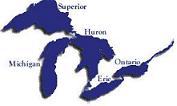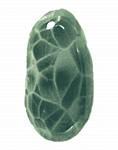 Michigan History for Kids | Michigan History Magazine for Adults
Michigan History for Kids | Michigan History Magazine for Adults
 Michigan History for Kids | Michigan History Magazine for Adults
Michigan History for Kids | Michigan History Magazine for Adults
Our Michigan Book Store and More
|
Lighthouses of Michigan: A Guidebook and Keepsake (Lighthouse Series)

Click the Great Lakes name on this map for more information about the Lake. |
State Flag
Michigan's official flag was adopted in 1911. The flag has a deep blue background and pictures an elk and around a blue shield labeled "TUEBOR," meaning "I will defend." The shield pictures a man with a raised hand and a gun, a rising sun, a peninsula and lakes. Over the shield is a bald eagle(holding an olive branch and a sheaf of three arrows) and a red ribbon reading "E PLURIBUS UNUM" (which is the motto of the U.S.A. and means "Out of Many, One" - this refers to the states of the United States being united into one country). Under everything lie two white ribbons that read "SI QUAERIS PENINSULAM AMOENAM" and "CIRCUM SPICE," which means, "If you are seeking a amenable (pleasant) peninsula, look around you."
 |
State Bird: Robin
After the robin (Turdus migratorius) was favored in a Michigan Audubon Society contest to choose a state bird, the Michigan legislature made it official. Proclaiming the poll in which 200,000 votes were cast "widely and generally conducted," House Concurrent Resolution 30 of 1931 designated the robin as Michigan's state bird. Legislators called the robin "the best known and best loved of all the birds in the State of Michigan." | |
| State Tree: White Pine
The towering white pine (Pinus strobus) is a symbol of one of Michigan's greatest industries--lumbering. From 1870 to the early 1900s, Michigan led the nation in lumber production. During those years a transportation network and communities grew across the state to accommodate the lumber boom. Public Act 7 of 1955 designated the white pine as the state tree. |
||
 |
State Gem: Chlorastrolite
Chlorastrolite (literally "green star stone") is also known as greenstone or Isle Royale greenstone. Like the Petoskey stone, chlorastrolite is often crafted into unique jewelry and souvenirs. The gem ranges in color from yellow-green to almost black and when polished shows a turtleback pattern. Primarily found in the Upper Peninsula, chlorastrolite was adopted as the state gem by Public Act 56 of 1972. |
|
 |
State Soil: Kalkaska Soil Series
Soil is a vital natural resource. First identified as a soil type in 1927, Kalkaska sand is one of more than 500 soils found in the state. Unique to Michigan, Kalkaska sand covers nearly a million acres in 29 Upper and Lower Peninsula counties. Designated as the state soil by Public Act 302 of 1990, Kalkaska sand has distinctive layers ranging in color from black to yellowish brown |
|
 |
State Flower: Apple Blossom
In 1897 Michigan legislators, feeling that "a refined sentiment" called for the naming of a state flower, designated the apple blossom. Joint Resolution 10 of that year noted "one of the most fragrant and beautiful flowered species of apple, the pyrus coronaria, is native to our state." Legislators also proudly declared that "Michigan apples have gained a worldwide reputation." A century later, Michigan ranks second in the nation in apple production. |
|
 |
State Fish: Brook Trout
More than twenty years after designating the trout as Michigan's state fish (Public Act 58 of 1965), the Michigan legislature specified one type of trout--brook (Salvelinus fontinalis). Native to Michigan and found throughout the state, the brook trout was adopted as the state fish by Public Act 5 of 1988. |
|
 |
State Stone: Petoskey Stone
The Petoskey stone is actually a fossilized coral (Hexagonaria pericarnata) from a coral reef that existed in the northern Lower Peninsula during the Devonian era, 350 million years ago. Adopted as the state stone by Public |
|
| State Reptile: Painted Turtle
Perhaps the most common of turtles, the painted turtle (Chysemys picta) owes its place among Michigan's state symbols to a group of Niles fifth-graders. After discovering that no reptile represented the state, the children approached their state representative and followed the legislative process to its enactment as Public Act 281 of 1995. |
||
 |
State Game Mammal: Whitetailed Deer
Found in every Michigan county, the white-tailed deer (Odocoileus virginianus) is an important natural and economic resource. Every year, deer hunting adds more than $400 million to the state's economy. Public Act 15 of 1997, designating the state game mammal, successfully completed the efforts of Zeeland fourth-graders to include the white-tailed deer among Michigan's official state symbols. |
Indian tribes were living in the Michigan region when the first European, Étienne Brulé of France, arrived in 1618. Other French explorers, including Jacques Marquette, Louis Joliet, and sieur de la Salle, followed, and the first permanent settlement was established in 1668 at Sault Ste. Marie. France was ousted from the territory by Great Britain in 1763, following the French and Indian Wars.
After the Revolutionary War, the U.S. acquired most of the region, which remained the scene of constant conflict between the British and U.S. forces and their respective Indian allies through the War of 1812. Bordering on four of the five Great Lakes, Michigan is divided into Upper and Lower peninsulas by the Straits of Mackinac, which link lakes Michigan and Huron. The two parts of the state are connected by the Mackinac Bridge, one of the world's longest suspension bridges. To the north, connecting lakes Superior and Huron, are the busy Sault Ste. Marie Canals.
While Michigan ranks first among the states in production of motor vehicles and parts, it is also a leader in many other manufacturing and processing lines, including prepared cereals, machine tools, airplane parts, refrigerators, hardware, steel springs, and furniture.
The state produces important amounts of iron, copper, iodine, gypsum, bromine, salt, lime, gravel, and cement. Michigan's farms grow apples, cherries, beans, pears, grapes, potatoes, and sugar beets. Michigan's forests contribute significantly to the state's economy. Forest-based industries (wood product industry, tourism, and recreation) support nearly 180,000 jobs and contribute over $18 billion to the state economy. With 10,083 inland lakes and 3,288 miles of Great Lakes shoreline, Michigan is a prime area for both commercial and sport fishing.
Points of interest are the automobile plants in Dearborn, Detroit, Flint, Lansing, and Pontiac; Mackinac Island; Pictured Rocks and Sleeping Bear Dunes National Lakeshores; Greenfield Village in Dearborn; and the many summer resorts along both the inland and Great Lakes.
Please Visit Links for You and More
**My
Specials at
Walmart, Click Here**